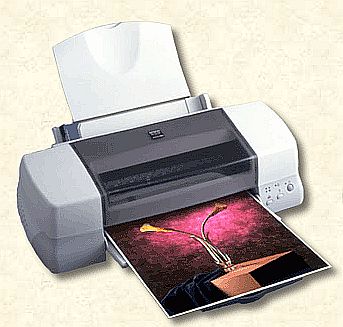The Epson 1270 printer
When it first appeared on the market six years ago, the Epson 1270 color dye ink jet printer was the first consumer priced printer which could make large – meaning 13†wide and up to 44†long – prints with high quality and repeatability. I bought mine new in March, 2000 for $539.05 and proceeded to produce hundreds of color and monochrome prints with it. First in 8†x 10â€, later in 13†x 19†sizes, which makes for a nice 22†x 28†wall sized matted, framed result.
I’m not writing this because the Epson has given up the ghost. Far from it. The only reason that I know exactly when I bought it and how much I paid is that I just resurrected the original shipping box from the attic and found the sales invoice in there. You see, the Epson will soon be making its way east to my nerdy friend whose current printer is limited to 8†x 10â€, and he know and loves the quality this machine is capable of, reliably producing at 13†x 19†prints.
Ink remains easily available, even if all the colors are in one cartridge and the Epson’s software is about as good at predicting the ink levels as the Federal Reserve is at predicting inflation. Which is to say it gets it in the ball park but don’t stake your life (or next print) on it. Epson sold a lot of these wonderful printers and given the profit margins on ink sales you can bet fresh ink cartridges will be available for a long time.
Conservatively, I’m guessing that the 1270 has at least another four good years left in it, which makes for a ten year life in a digital age where products are seemingly obsolete days after hitting the market. Epson made the 1270 obsolete soon after I bought mine and eventually switched to pigment based inks with claims of great longevity. Didn’t worry me one bit. I have framed originals which are six years old and they look as fresh as the day they were made. I simply do not display them in full daylight eight hours a day.
One of the great appeals of the Epson 1270 was that its use of dye based inks, despite their reputation for fading, resulted in a color print quality very similar to that obtained with the old Cibachrome process. This was, for most, not something to be undertaken at home, as the temperature margins of the chemicals were narrow to put it mildly and their toxicity comparable to the effluent from Chernobyl. What Cibachrome gave you was a wonderful depth of color albeit at the expense of high contrast, so it matched up nicely with milder emulsions like Kodachrome II and, later, Kodachrome 25 and 64, provided your exposure was spot on. Paired with that old grain hound GAF/Ansco 500, Cibachrome was a dream. It was a strict teacher, but get the exposure right and the dynamic range was there for all to see.
The only reason the 1270 is moving on is that I find I want to make 16†x 20†and 18†x 24†prints more often, and if that does not sound like much of a change the latter size is almost twice the area of 13†x 19â€. That’s a lot bigger when it comes to visual impact.
So B&H Photo has an order from me for a Hewlett Packard DesignJet 90 (they are backlogged, suggesting the secret is out) offering dye based inks which, miracle of miracles, are allegedly fade resistant. I toyed with the idea of the Design Jet 130 model which goes up to 24†wide, but concluded that prints that large were pretty much the exception rather than the rule for me, so common sense prevailed over machismo.
Truth be told, I am a tad apprehensive about the new printer. Not that installing the thing worries me – heck, with an Apple iMac it’s just one more ‘Plug and Play’ exercise. No, as a long time user of HP’s 12C calculator (a device now some 25 years old!) my wariness results from my all too great familiarity with HP’s instruction manuals. Hewlett Packard was always an engineer’s company, run by and for engineers, with the brief exception of a disastrous, mercifully brief, time under a chief executive who confused her posterior with her elbow daily, while spending far too much time on the former in the corporate jet. Now that the company has returned as an engineering powerhouse, I’m afraid that the same people who wrote the manual for my 12C calculator will have been involved in the book for the DesignJet. They or their kids.
On the other hand, like all good engineers, they probably believe that instructions are for losers, so the first thing I propose to do when the machine finally arrives is to pitch the instruction book. Worked with the HP 12C and Reverse Polish Notation was never an issue for this Pole. Any descendant of a proud nation that can charge Panzers on horseback needs no instruction book. And it doesn’t hurt that I have an honors degree in Engineering earned before the days of ‘open book’ exams.
Goodbye Epson. You delivered beyond any rational expectations.
